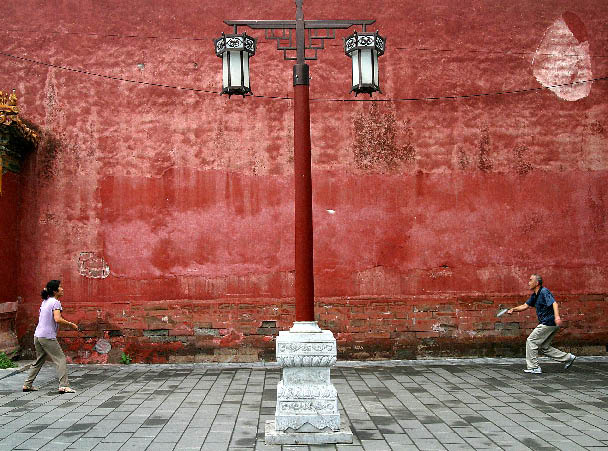| Badminton Always a Hit
By staff reporter ZHU HONG
 |
|
Badminton is easy to play even with a makeshift court. China Foto Press |
AFTER rushing through his dinner, Ma Xiaolei quickly changes into his sporting gear and zooms over to the badminton courts. By day Ma runs a photo studio in Beijing, but his real passion is playing badminton.
Enthusiastic Amateurs
The apparent fondness for badminton in China was confirmed in a recent survey of current public sporting trends; badminton remains one of the most popular forms of exercise just behind walking and jogging.
Ma Xiaolei described his thoughts on why badminton emerged in popular culture in the late 1990s and its surge in 2003. He explained how that in the 1990s as the country’s economy grew, and people’s living conditions began to experience significant improvement, people had more free time and money to enjoy leisure sports. The government also began subsidizing the construction of public sporting centers. Ma still remembers the excitement he felt when the Capital Indoor Stadium first opened its badminton courts.
In 2003, China was hit with an outbreak of SARS (Severe Acute Respiratory Syndrome). This helped people realize the importance of physical exercise in enhancing the body’s immunity and resistance to disease. “However,” as Ma points out, “playing sports like tennis or golf tend to cost too much, and activities like football and basketball are too strenuous for the older folks. Badminton is the ideal sport for providing optimum exercise at an affordable cost.”
Playing badminton three times a week is an essential part of Ma Xiaolei’s life. He knows all Beijing’s badminton stadiums very well, and applauds the growing member of newly-built courts. Ma still has to reserve what courts there are days in advance since all the stadiums in the city are packed with badminton players. One of the heads of the Capital Indoor Stadium pointed out that many people now have to play in the morning since it’s hard to reserve a court for the afternoons and evenings.
Healthy Socializing
Apart from a healthy physique, badminton has also brought Ma a circle of friends, most of whom are parents like himself who send their own children to badminton training classes. They often play together up to three times a week, in three hour sessions for which they split court fees.
There are also many badminton clubs for enthusiasts to join that provide the necessary equipment as well, charging members only RMB 25 to 30 each time. Many singles have even found their Mr. or Mrs. Right over a good game of badminton. Nowadays, playing badminton has become an ideal way to socialize. Companies often organize competitions to promote cross communication among their employees. On one hand, sport weakens the concepts of social status; on the other, it is good for health. “We used to invite friends or colleagues to have a drink or go out for a big meal, which is a lavish and unhealthy custom,” Ma says. “But people now are positive that ‘it is better to invite your friends to enjoy some physical exercise rather than simply taking them to a restaurant.’”
For the Love of the Game
Over the past few years, Ma Xiaolei has been training with professional coach Zou Liang. Zou received badminton training as a kid and was one of the leading players for the Beijing Badminton Team before his retirement. The enthusiasm of badminton fans encouraged him to devote himself to teaching the sport.
There are quite a few amateurs whose playing levels match those of professional players. Luckily the competitions available are increasing today. The most renowned matches include the National Amateur Badminton Competition and the Guangzhou Mayor Cup Public Badminton Serial Championship. Even a simple match held by some local community centers may draw thousands of participants.
Playing has its dangers and sometimes ends in pain. Ma has bruised his ankles and knees all too often. “We amateurs tend to ignore the important warm-up and cool-down exercises. Wrong postures and weakening muscles can lead to injury. But I’ve never regretted that.” Ma concludes, “In the past 20 years my happiest moments have been when I’m on the court!” | 